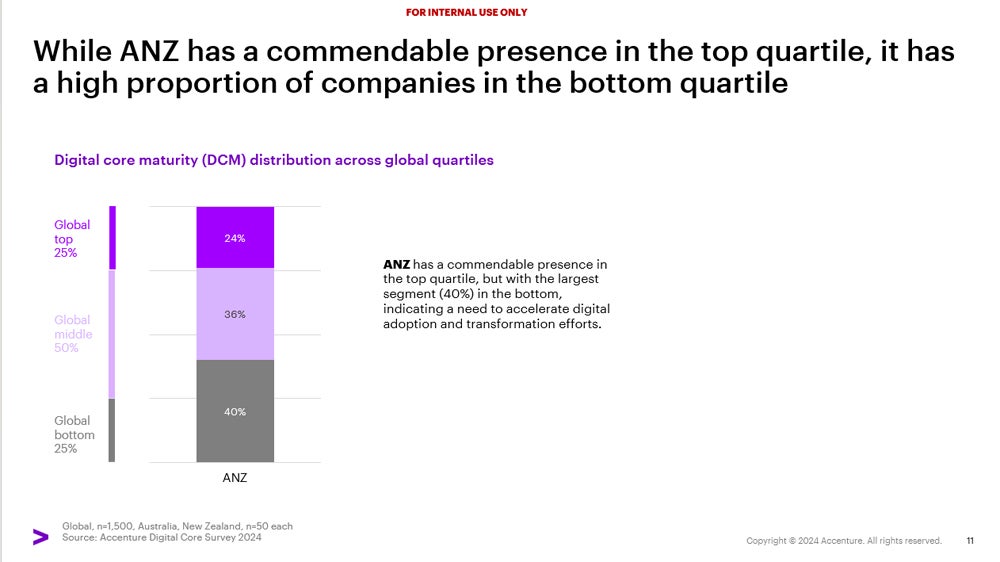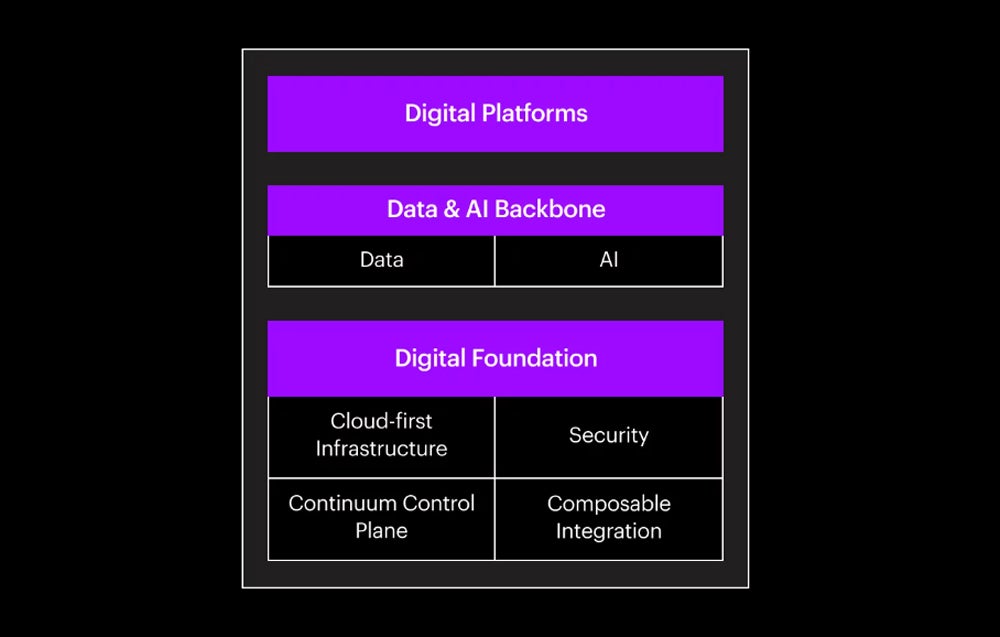A disproportionately large share of local Australian businesses are struggling to keep up with the pace of global digital adoption and transformation, according to new data from Accenture’s local division.
The consultancy found that 40% of local companies rank in the bottom quartile of companies when ranked by their level of digital maturity compared to global competitors in countries across North America, Europe and Asia.
Matt Coates, chief technology officer at Accenture Australia and New Zealand, told TechRepublic:
- Local businesses will need to consider investing a larger portion of their IT budgets in strategic innovation rather than simply maintaining existing systems to keep pace.
- Companies should also take a balanced approach to managing technical debt; Accenture advises its clients to allocate 15% of their IT budgets to debt remediation.
Digital maturity was ranked based on how far along they are in adopting a “digital core,” a term Accenture uses to describe the cloud infrastructure, digital platforms, data architecture and security backbone that enable an organization to innovate and grow.
Australian companies are not as digitally mature as their global counterparts
Accenture ranked the digital maturity of global companies in its Reinventing with a Digital Core report. The report revealed that 40% of the 50 Australian organisations surveyed were ranked in the bottom quartile of global companies, meaning Australia has a significant number of companies that do not meet this standard.
In contrast, Australia's top companies performed better than those in the rest of the world: 24% of local organisations were represented in the top 25% worldwide. A further 36% were assessed as falling into the “global average” for digital maturity or the middle two quartiles.

“We’ve known for some time that the digital capabilities of organisations in Australia are very varied,” Coates said. While he said the top 25 per cent of organisations in Australia appear to be keeping pace with their global counterparts, “then there’s quite a steep drop-off” for those at the bottom, he said.
Growth and profits are left aside
Australian organisations that fall behind in digital transformation may be missing out on significant business benefits. Accenture research suggests that companies with an advanced digital core have experience in:
- Revenue growth rates up 20%.
- 30% more profitability worldwide.

When combined with investments in strategic innovation and a balanced approach to technical debt, these efforts can lead to a 60% higher revenue growth rate and 40% higher profits, Accenture found.
WATCH: Australian companies ranked fourth in 2024 global survey on generative AI use
What factors are holding back businesses?
Accenture outlined several reasons why Australian organisations are lagging behind their global competitors in digital adoption.
A “short-term” mentality
According to Accenture, some business leaders still mistakenly view digital transformation as a cost rather than a driver of growth. “We know this isn’t the case if the right strategy is in place, but this short-term mindset persists and results in inadequate investment in technology,” Coates said.
How to balance technology debt with innovation spending
Many organizations struggle to manage technology debt in a way that allows them to innovate. “Technical debt management remains a significant challenge; many organizations fail to balance spending between debt remediation and investments in future growth,” Coates explained.
Cultural resistance to digital and change
While CIOs, CTOs and CFOs across Australia are strong advocates of digital adoption and maturity, internal cultural resistance can hold them back. Coates said that, to the frustration of senior technology leaders, there is often difficulty in getting this adopted in local organisations.
Technological challenges include the human factor
Accenture research indicates that while many ANZ executives have embraced digital platforms, 61% say these platforms are not being used effectively within their organisations. A further 41% say integrating these new technologies is an external struggle.
Coates attributes some digital adoption problems to people within organizations rather than the technology itself.
“In the market, we see that these types of problems occur if effective change management and talent training programs are not included in the technological strategy,” he explained.
Hybrid cloud, data governance and cybersecurity risk are all challenges
Technologies that local organizations struggle to adopt include, in particular:
Cloud: Accenture sees partial cloud migrations as a problem. “Cloud transformations often stall due to the complexities of hybrid environments and legacy systems,” Coates said.
SEE: Gartner's 7 Big Predictions for Cloud Computing
Data: Australian businesses face challenges in ensuring data quality and governance, which is “critical to effective decision making and [for] embracing new emerging technologies like Gen AI,” Coates said.
Cybersecurity: Organizations must strengthen security frameworks and compliance measures to protect against evolving threats and ensure regulatory compliance as risks grow exponentially.
How to boost the maturity of your organization's digital core
Coates laid out three recommendations for companies looking to build a leading digital core.
Educate stakeholders on the benefits of a strong digital core
Educating stakeholders is a crucial part of the digital transformation battle. Accenture advocates for Australian IT leaders to focus on educating their entire organisations on the importance of a strong digital core. Coates said this is no longer limited to “the technology department”.
“Technology is at the core of every business today, and the potential of AI will keep it there,” Coates said.
“Once all leaders understand how critical the digital core is to a company’s ability to adopt new technologies and remain agile and competitive, they will be more likely to show the commitment needed to invest in a strategic work program to achieve digital transformation.”
Allocate sufficient IT budget to strategic innovation for the future
Companies should consider investing a larger portion of their IT budgets into strategic innovation rather than simply maintaining existing systems. Accenture’s global research showed that top-quartile companies were consistently increasing their IT budgets on strategic innovation by at least 6% year-over-year.
However, Coates said it is crucial to balance this investment in innovation with the need to manage technical debt.
“We recommend our clients allocate approximately 15% of their IT budgets to debt remediation to keep IT capabilities running while investing in future growth,” he said.
Creating a culture that prioritizes digital supremacy
Finally, Coates said a cultural shift toward continuous reinvention is needed, with a focus on:
- Develop digital skills.
- Promote innovation.
- Foster an environment that embraces change.
“By addressing these areas,” he explained, “ANZ organisations can close the digital divide and better compete on the global stage.”











